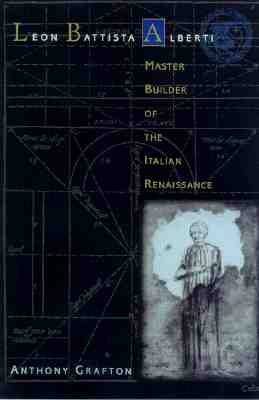“[Grafton] has produced a convincing and engaging account of Alberti's intellectual milieu in what is arguably the most important general contribution to Albertian studies of recent decades.[Grafton] has produced a convincing and engaging account of Alberti's intellectual milieu in what is arguably the most important general contribution to Albertian studies of recent decades.[Grafton] has produced a convincing and engaging account of Alberti's intellectual milieu in what is arguably the most important general contribution to Albertian studies of recent decades.[Grafton] has produced a convincing and engaging account of Alberti's intellectual milieu in what is arguably the most important general contribution to Albertian studies of recent decades.”
— Bruce Boucher New York Times on Leon Battista Alberti: Master Builder of the Italian Renaissance
Leon Battista Alberti: Master Builder of the Italian Renaissance
by Anthony Grafton
A lucid biographical study of a key figure of European culture
Leon Battista Alberti (1404-72) was one of the most original, creative, and exciting figures of the Italian Renaissance. He wrote the first modern treatise on painting, the first modern manual of classical architecture, and a powerful set of “dialogues” about the princely families that dominated his home city of Florence. He rediscovered the forgotten aesthetics of classical architecture and described, in incomparably vivid terms, the artistic revolution in Florence that began what we now call the Renaissance. But Alberti was more than a mere chronicler—he practiced what he preached. He made spectacular advances in the art of painting and in engineering, and as an architect he was responsible for some of the most exciting buildings in Italy. Yet in spite of his central importance, work on Alberti has for the most part been confined to scholarly monographs. Here, one of our greatest Renaissance scholars offers the general book that Alberti has so long deserved. This is a compelling portrait of a mysterious, original, and highly unusual intellectual, and a colorful tableau of the cities and courts in which he lived and worked.A lucid biographical study of a key figure of European culture
Leon Battista Alberti (1404-72) was one of the most original, creative, and exciting figures of the Italian Renaissance. He wrote the first modern treatise on painting, the first modern manual of classical architecture, and a powerful set of “dialogues” about the princely families that dominated his home city of Florence. He rediscovered the forgotten aesthetics of classical architecture and described, in incomparably vivid terms, the artistic revolution in Florence that began what we now call the Renaissance. But Alberti was more than a mere chronicler—he practiced what he preached. He made spectacular advances in the art of painting and in engineering, and as an architect he was responsible for some of the most exciting buildings in Italy. Yet in spite of his central importance, work on Alberti has for the most part been confined to scholarly monographs. Here, one of our greatest Renaissance scholars offers the general book that Alberti has so long deserved. This is a compelling portrait of a mysterious, original, and highly unusual intellectual, and a colorful tableau of the cities and courts in which he lived and worked.A lucid biographical study of a key figure of European culture
Leon Battista Alberti (1404-72) was one of the most original, creative, and exciting figures of the Italian Renaissance. He wrote the first modern treatise on painting, the first modern manual of classical architecture, and a powerful set of “dialogues” about the princely families that dominated his home city of Florence. He rediscovered the forgotten aesthetics of classical architecture and described, in incomparably vivid terms, the artistic revolution in Florence that began what we now call the Renaissance. But Alberti was more than a mere chronicler—he practiced what he preached. He made spectacular advances in the art of painting and in engineering, and as an architect he was responsible for some of the most exciting buildings in Italy. Yet in spite of his central importance, work on Alberti has for the most part been confined to scholarly monographs. Here, one of our greatest Renaissance scholars offers the general book that Alberti has so long deserved. This is a compelling portrait of a mysterious, original, and highly unusual intellectual, and a colorful tableau of the cities and courts in which he lived and worked.A lucid biographical study of a key figure of European culture
Leon Battista Alberti (1404-72) was one of the most original, creative, and exciting figures of the Italian Renaissance. He wrote the first modern treatise on painting, the first modern manual of classical architecture, and a powerful set of “dialogues” about the princely families that dominated his home city of Florence. He rediscovered the forgotten aesthetics of classical architecture and described, in incomparably vivid terms, the artistic revolution in Florence that began what we now call the Renaissance. But Alberti was more than a mere chronicler—he practiced what he preached. He made spectacular advances in the art of painting and in engineering, and as an architect he was responsible for some of the most exciting buildings in Italy. Yet in spite of his central importance, work on Alberti has for the most part been confined to scholarly monographs. Here, one of our greatest Renaissance scholars offers the general book that Alberti has so long deserved. This is a compelling portrait of a mysterious, original, and highly unusual intellectual, and a colorful tableau of the cities and courts in which he lived and worked.

